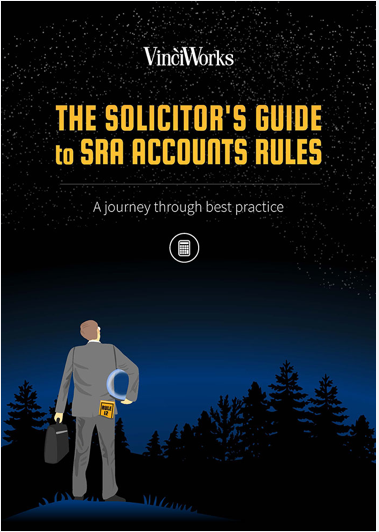Big Data Protection – how your business can harness the power of data while minimising risk
The business world has been excited about the potential of big data ever since the term was first coined in 2001. While information has always been a critical element of forming business strategy, big data means taking advantage of modern levels of computational power and data availability to extract meaningful insight from extremely large datasets […]
Fraud detection red flags: 12 common signs to look out for
Fraud continues to be a high profile news story: in the last week, a former Ukip MEP has been jailed over £500k expenses fraud, the finance director of Bannatyne Group was in court over fraud amounting to £8m, and it was revealed that in 2014 insurance fraud was worth an incredible £1.32bn. Fraud, or deception for personal gain […]
Free compliance guide: SRA Accounts Rules

Vinciworks, the leader in online compliance learning, has just released a free guide to the SRA Accounts Rules, which includes hot topics, key definitions and best practice. This guide will come in handy when you need to quickly reference topics such as “office money vs. client money” and “matter completion.” You will constantly be able […]
VinciWorks product updates June 2015
New course: SRA Accounts Rules: A Practical Overview Next course: Equality & Diversity: A Practical Overview (We are looking for course reviewers. One hour of your time. Free access for one year to reviewer firms. Click here if you are interested.) Risk Management System version 2 to be released this month New RMS feature: Edit risks right in the grid […]
Six eLearning administration pains and our Astute solutions
Managing eLearning is a complicated and ongoing task, leading many organisations to hire staff dedicated solely to this function. With responsibilities including managing learners, eLearning courses, enrolments, communications and reports, to name a few, the administrative burden on staff responsible for eLearning is large. We’re about to release our brand new eLearning platform, Astute. Throughout […]
Changes to CPD explained in two templates

As we have reported previously, our poll found that over 50% of solicitors plan to transition to the new approach to continuing competence before it becomes mandatory on 1 November 2016. The SRA has published a toolkit with detailed guidance on how to comply with the new approach. However, some of the information is confusing. We have chosen to […]
Compliance News roundup for June 2015
Microsoft to end support for Server 2003 on 14 July (third of UK still using it)–CRN Cybercrime is escalating–SRA Law Society: “Piecemeal” SRA reforms could create “perverse incentives”–Legal Futures Gender gap in lawyers’ salaries persists as men pick up bigger pay rises–The Lawyer Ombudsman complaint limit rises from six to 12 months starting 9 July–The […]






